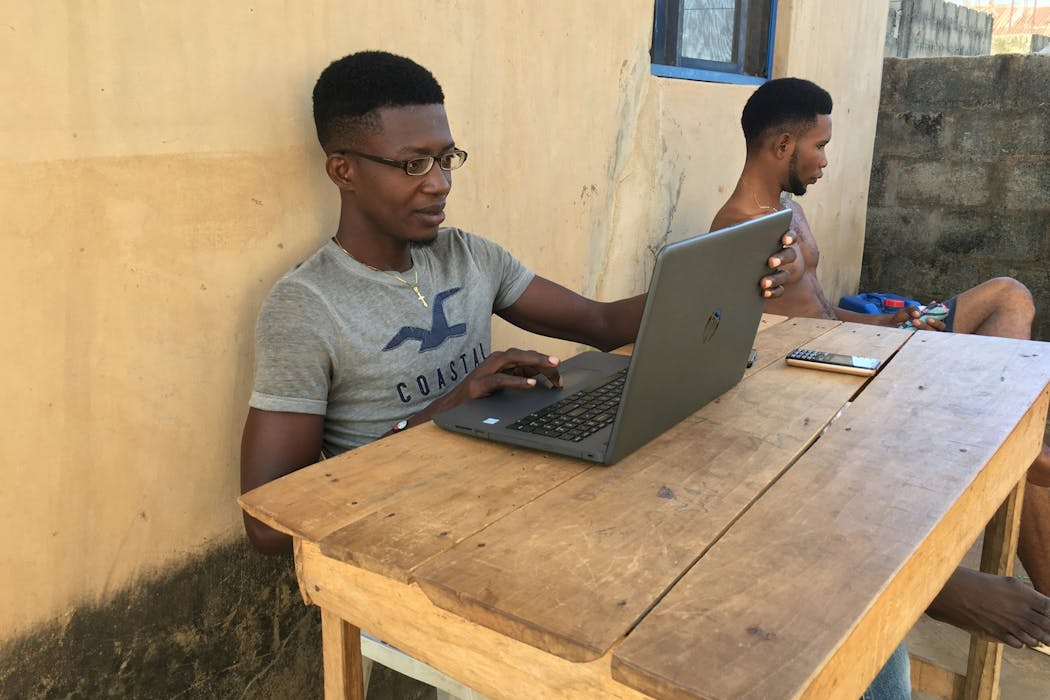- Home
Edition
Africa Australia Brasil Canada Canada (français) España Europe France Global Indonesia New Zealand United Kingdom United States Edition:
Global
Edition:
Global
- Africa
- Australia
- Brasil
- Canada
- Canada (français)
- España
- Europe
- France
- Indonesia
- New Zealand
- United Kingdom
- United States
 Academic rigour, journalistic flair
Distance learning changes lives, but comes with its own challenges
Published: November 27, 2025 2.01pm GMT
Ashley Gunter, University of South Africa
Academic rigour, journalistic flair
Distance learning changes lives, but comes with its own challenges
Published: November 27, 2025 2.01pm GMT
Ashley Gunter, University of South Africa
Author
-
 Ashley Gunter
Ashley Gunter
Professor, University of South Africa
Disclosure statement
Ashley Gunter receives funding from, The Arts and Humanities Research Council UK, British Academy UK, National Research Foundation, Newton Fund UK.
Partners
University of South Africa provides funding as a partner of The Conversation AFRICA.
View all partners
DOI
https://doi.org/10.64628/AAJ.5gr9g65uw
 For students outside cities, participation in distance learning can be a lonely struggle.
Tobi Oshinnaike via Unsplash
https://theconversation.com/distance-learning-changes-lives-but-comes-with-its-own-challenges-266431
https://theconversation.com/distance-learning-changes-lives-but-comes-with-its-own-challenges-266431
Link copied
Share article
For students outside cities, participation in distance learning can be a lonely struggle.
Tobi Oshinnaike via Unsplash
https://theconversation.com/distance-learning-changes-lives-but-comes-with-its-own-challenges-266431
https://theconversation.com/distance-learning-changes-lives-but-comes-with-its-own-challenges-266431
Link copied
Share article
Share article
Copy link Email Bluesky Facebook WhatsApp Messenger LinkedIn X (Twitter)Print article
Across Africa, distance education has become one of the most powerful forces for expanding access to higher learning. Open and distance learning institutions such as the Open University of Tanzania, the Zimbabwe Open University and the National Open University of Nigeria have joined long-standing providers like the University of South Africa in offering flexible study opportunities to millions of students who would otherwise be excluded from higher education.
These institutions are reimagining what it means to go to university in contexts where geography, cost and social responsibilities often keep young people out of the classroom.
Read more: How place of birth shapes chances of going to university: evidence from 7 African countries
The value of distance education is undeniable. It allows working adults to continue their studies without leaving employment, gives rural youth the chance to stay in their communities while earning qualifications, and provides people with opportunities to balance learning alongside family responsibilities. During crises such as the COVID-19 pandemic, distance education proved to be a lifeline when face-to-face teaching was impossible.
Across the continent, it is not simply an alternative to traditional universities; for many, it is the only route into higher education.
The World Bank has reported that only 9% of the African population in the five years after secondary school is enrolled in tertiary education – the lowest rate in the world.
My own research takes the University of South Africa (Unisa) as a case study to dig deeper into how geography and inequality shape students’ experiences of distance learning: their access, participation, and outcomes. With over 370,000 students in South Africa and other countries, Unisa is the continent’s largest provider. It’s an ideal lens through which to understand both the promise and the challenges of this educational model.
I’m a geographer with an interest in international education and economic development. For the Unisa case study, I took a qualitative research approach, interviewing 28 Unisa postgraduate students from different regions of Africa. I chose them to reflect the diversity of students enrolled at Unisa and because they already had experience of studying.
The study found that although distance education can meet educational needs where people can’t access face-to-face learning, it’s not a perfect solution. There are still challenges which make it hard for some people to study, like inadequate infrastructure (poor internet connectivity and electricity supply), financial constraints, and language and cultural barriers. There’s a need for interventions to improve the effectiveness and equity of distance education.
Experiences of distance education
My interviews with postgraduate students across Africa showed a complex picture. For the 18 students based in cities, distance education can be genuinely empowering. Internet connections, though costly, are usually accessible in cities. Electricity supply is more stable, and digital platforms are within reach. Students in urban areas spoke of the freedom and flexibility they gained, describing distance education as the only way to balance work, family life and study.
But geography matters. For students in rural or marginalised regions, participation in distance learning can become a daily struggle.
Downloading a file may take hours. Travelling long distances to internet cafés eats into scarce time and resources. A student in Zimbabwe explained how he missed deadlines simply because the university portal would not load in his village. Another said:
Some days I feel like I’m learning less and figuring out how to connect more.
Another, in Kenya, described travelling to Nairobi every two weeks to collect academic materials. She felt the sacrifice was worth it because she knew education could change her life. For others:
I begin to wonder if it’s really worth it.
These obstacles, however, underline rather than diminish the value of distance education. Students are willing to endure enormous effort and cost to access learning because they believe in its power to transform their futures. Their determination is itself evidence of the demand for and importance of this model of education.
Still, the barriers are real. High data prices, unstable internet, and unreliable electricity continue to limit access. Women in rural areas often face additional responsibilities that leave them with little time or energy to study.
It’s hard to keep up with my guy classmates who don’t face the same rules at home.
And the flexibility that makes distance education attractive can sometimes turn into a sense of isolation when students don’t have peer support.
I feel alone a lot. Even when I try to share, they don’t seem to understand what I’m facing.
Persistent inequities in distance education
Distance education can actually keep existing inequities in place, because students from wealthier, urban backgrounds are better positioned to succeed than rural students are.
My study also revealed how the realities of students’ lives not only affect their ability to use digital tools but also their sense of belonging to the academic community. There is a growing digital divide within distance education itself.
The task ahead is to make sure that these challenges do not undercut the progress distance education has already made. Over the past decade, distance education has expanded access, increased enrolment far beyond the capacity of traditional campuses, and improved the quality of digital teaching, learner support, and flexible study pathways.
Investment in affordable broadband and electricity is essential, particularly in rural and underserved regions. Financial aid needs to cover the hidden costs of learning, from devices to data. Outreach centres should be located closer to marginalised communities, and policies must explicitly address the gendered realities that shape women’s access to higher education.
Read more: Hunger among South African students: study shows those studying remotely need financial aid for food
Across Africa, open universities have already demonstrated how distance education can widen participation and build inclusive futures. Unisa’s story, and the experiences of its students, highlight both the opportunities and the work still to be done.
Geography continues to shape who can learn, but it does not have to decide who gets left behind. With the right investments and policies, distance education can move closer to fulfilling its full promise: to provide equitable, life-changing access to higher learning for all.
- Universities
- Higher education
- Students
- Youth
- Online learning
- Tertiary education
- African students
- distance education
Events
Jobs
-
 Senior Lecturer, Human Computer Interaction
Senior Lecturer, Human Computer Interaction
-
University Lecturer in Early Childhood Education
-
 Case Specialist, Student Information and Regulatory Reporting
Case Specialist, Student Information and Regulatory Reporting
-
 Lecturer in Paramedicine
Lecturer in Paramedicine
-
 Associate Lecturer, Social Work
Associate Lecturer, Social Work
- Editorial Policies
- Community standards
- Republishing guidelines
- Analytics
- Our feeds
- Get newsletter
- Who we are
- Our charter
- Our team
- Partners and funders
- Resource for media
- Contact us
-
-
-
-
Copyright © 2010–2025, The Conversation

 Senior Lecturer, Human Computer Interaction
Senior Lecturer, Human Computer Interaction
 Case Specialist, Student Information and Regulatory Reporting
Case Specialist, Student Information and Regulatory Reporting
 Lecturer in Paramedicine
Lecturer in Paramedicine
 Associate Lecturer, Social Work
Associate Lecturer, Social Work

